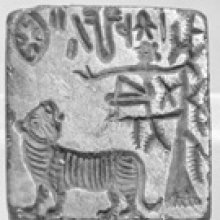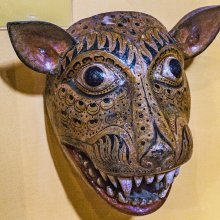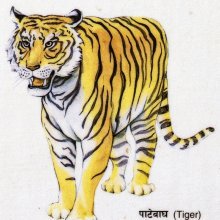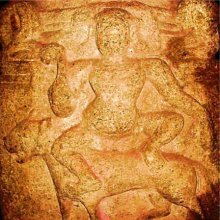Tiger: 4 definitions
Introduction:
Tiger means something in Buddhism, Pali, Hinduism, Sanskrit, the history of ancient India. If you want to know the exact meaning, history, etymology or English translation of this term then check out the descriptions on this page. Add your comment or reference to a book if you want to contribute to this summary article.
Images (photo gallery)
(+41 more images available)
In Hinduism
Natyashastra (theatrics and dramaturgy)
Source: Shodhganga: Elements of Art and Architecture in the Trtiyakhanda of the Visnudharmottarapurana (natya)Tigers are associated with Makarahasta: one of the thirteen Combined-hand Gestures (in Indian Dramas) (known as saṃyuktahastas), according to the Viṣṇudharmottarapurāṇa, an ancient Sanskrit text which (being encyclopedic in nature) deals with a variety of cultural topics such as arts, architecture, music, grammar and astronomy.—According to the Śabdakalpadruma, makara means sea-animals like Kumbhīra, Kūrma, Kāca, Godhā, Śaṅkava, Śvaṇitaka, Śiśumāra etc. According to the Viṣṇudharmottarapurāṇa, in Makara posture both of the hands in patāka posture are placed one over the other and both should be facing downward. This posture is used in the acting of lion, tiger and deer.

Natyashastra (नाट्यशास्त्र, nāṭyaśāstra) refers to both the ancient Indian tradition (shastra) of performing arts, (natya—theatrics, drama, dance, music), as well as the name of a Sanskrit work dealing with these subjects. It also teaches the rules for composing Dramatic plays (nataka), construction and performance of Theater, and Poetic works (kavya).
Ayurveda (science of life)
Toxicology (Study and Treatment of poison)
Source: Shodhganga: Kasyapa Samhita—Text on Visha ChikitsaThe study of Tigers (habitat, infections and treatment) is dealt with in the Kāśyapa Saṃhitā: an ancient Sanskrit text from the Pāñcarātra tradition dealing with both Tantra and Viṣacikitsā—an important topic from Āyurveda which deals with the study of Toxicology (Viṣavidyā or Sarpavidyā).—The twelfth adhyāya of the Kāśyapasaṃhitā consisting sixty-six verses dwells upon twenty kinds of venom and the treatment administered therein. Verses (1-42) discuss at length, various species like [e.g., tigers], their sub-varieties, the infection caused by their bite or sting and the appropriate eight types of effective medication like treating thirst, incision, removal of excess water content, ablutions, medicated drinks, liniments and nasal sprays to be administered for curing the same

Āyurveda (आयुर्वेद, ayurveda) is a branch of Indian science dealing with medicine, herbalism, taxology, anatomy, surgery, alchemy and related topics. Traditional practice of Āyurveda in ancient India dates back to at least the first millenium BC. Literature is commonly written in Sanskrit using various poetic metres.
In Buddhism
Tibetan Buddhism (Vajrayana or tantric Buddhism)
Source: academia.edu: The Structure and Meanings of the Heruka MaṇḍalaThe Tiger is associated with the Yoginī (female deity) named Vyāghrī, being situated in the Medinīcakra, according to the 10th century Ḍākārṇava-tantra: one of the last Tibetan Tantric scriptures belonging to the Buddhist Saṃvara tradition consisting of 51 chapters.—Accordingly, the medinīcakra refers to one of the three divisions of the dharma-puṭa (‘dharma layer’), situated in the Herukamaṇḍala. The 36 pairs of Ḍākinīs [viz., Vyāghrī] and Vīras are yellow in color; the shapes of their faces are in accordance with their names [e.g., Tiger]; they have four arms; they hold a skull bowl, a skull staff, a small drum, and a knife.

Tibetan Buddhism includes schools such as Nyingma, Kadampa, Kagyu and Gelug. Their primary canon of literature is divided in two broad categories: The Kangyur, which consists of Buddha’s words, and the Tengyur, which includes commentaries from various sources. Esotericism and tantra techniques (vajrayāna) are collected indepently.
India history and geography
Source: Singhi Jain Series: Ratnaprabha-suri’s Kuvalayamala-katha (history)Tigers were commonly depicted on the Saṃsāracakra paintings (representing scenes of animal life), in ancient India, as mentioned in the Kathās (narrative poems) such as Uddyotanasūri in his 8th-century Kuvalayamālā (a Prakrit Campū, similar to Kāvya poetry).—Page 185.21 f.: Here follows a description of a printed scroll illustrating the Jaina conception of saṃsāracakra. [...] The saṃsāra-cakra illustrated the three worlds of hell, human world and the world of gods. [For example:] Fight between a tiger and a wild bull, and killing of a tiger with bull horns.

The history of India traces the identification of countries, villages, towns and other regions of India, as well as mythology, zoology, royal dynasties, rulers, tribes, local festivities and traditions and regional languages. Ancient India enjoyed religious freedom and encourages the path of Dharma, a concept common to Buddhism, Hinduism, and Jainism.
See also (Relevant definitions)
Starts with: Tiger aloe, Tiger bean, Tiger grass, Tiger lily, Tiger steam, Tiger wood, Tiger-spot poison, Tigerin-wuri, Tigerinyi, Tigerwood.
Full-text (+851): Vyaghra, Shardula, Vaiyaghra, Dvipin, Vyaghra-carman, Pridaku, Guhashaya, Hunda, Jihvapa, Tikshnadamshtra, Mrigaraj, Mrigad, Citrakaya, Mrigapati, Dvaipa, Mrigari, Himsira, Vicitranga, Purushavyaghra, Maruvaka.
Relevant text
Search found 243 books and stories containing Tiger; (plurals include: Tigers). You can also click to the full overview containing English textual excerpts. Below are direct links for the most relevant articles:
Folklore of the Santal Parganas
Chapter 5 - The Jackal and the Tigers < [Appendix]
Chapter LXXIV - The Tiger’s Foster Child < [Part I]
Chapter XLVI - The Killing of the Tiger < [Part I]
The Tiger < [July – September, 1983]
Jim Corbett – Man and His Mission < [January – March, 2002]
The Tiger and The Cow < [January 1963]
Animal Kingdom (Tiryak) in Epics (by Saranya P.S)
Patipada (by Acariya Maha Boowa Ñanasampanno)
Chapter III - The Story Of The White-robed Upasaka
Chapter II - Training The Mind
Trishashti Shalaka Purusha Caritra (by Helen M. Johnson)
Part 11: Death of Parvata < [Chapter II - Vāsupūjyacaritra]
Part 13: Sixth incarnation of Kamaṭha < [Chapter II - Previous births of Pārśvanātha]
Part 8: Sermon on rāga and dveṣa < [Chapter II - Śrī Aranāthacaritra]
Kautilya Arthashastra (by R. Shamasastry)
Chapter 3 - Remedies against National Calamities < [Book 4 - Removal of Thorns]
Chapter 29 - The Superintendent of Cows < [Book 2 - The duties of Government Superintendents]
Chapter 2 - Division of Land < [Book 2 - The duties of Government Superintendents]
Related products









